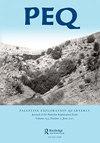Some thoughts about Words
IF 0.8
2区 历史学
0 ARCHAEOLOGY
引用次数: 0
Abstract
An editor’s work is inevitably wrapped up in words, it is therefore fitting to spend a little time considering the nature and power of words in general, and particularly words from the ancient civilisations of the Near East. Words are the building blocks of literature, but in the ancient world words did not always have the same relationship with their referents that they do in most modern societies. Several submissions to this journal have been focusing on textual material, the results of ancient compositions—texts. To the casual reader it may seem quite natural that words have always related to their referents in the same way they do today, in our language. Such assumptions could easily lead to a complete misunderstanding of what the words were meant to convey. Since words are the medium of literature, a society’s understanding of literature will be closely connected to that society’s understanding of the nature of words. That understanding may be consciously formulated among modern linguists, psychologists, and philosophers. But most of the time words are understood the way they are habitually used in contemporary society. If we are to learn how ancient societies understood words, we must examine the extant literature to see how words are described and defined, how they functioned. In the modern world, we regard words almost exclusively as symbols by which we communicate ideas and feelings with one another. The word stands for or represents the realities about which information is communicated. The word as a word is perceived to be quite distinct from the reality it stands for, its referent. In the ancient Near East—Mesopotamia, the Levant, and Egypt—the word had additional qualities. The word was not simply an expression of thought, but also an active force. It is as if the word passed on the actual reality of the thought being expressed. Words were invested with extraordinary attributes and even power, particularly if uttered by a divinity. But anyone who spoke a word could transmit the reality of the word. That is why, in the story in the Hebrew Bible, the Moabite king Balak asked Balaam to curse the Israelites (Num 22:2 ff.). Ancient Near Eastern literature, including the Hebrew Bible, may seem somewhat remote if we do not realise that the authors and editors considered words, the literary medium, capable of effects well beyond that of mere communication. I have on several occasions told my biblical studies colleagues that as an archaeologist my concerns are really the same as their concerns. After all, we are both seeking a better understanding of the ד ב ר (dabar). And in the very word for ‘word’—dabar—we find a fundamental difference in the comprehension of the reality of the ‘word’ in ancient Near Eastern literature when compared with most modern understandings of ‘word’. In addition to being a symbol the word is also a physical or metaphysical reality, a thing or a case. The word can be more than a mere symbol, it can be the referent itself.关于Words的几点思考
编辑的工作不可避免地要被文字包裹起来,因此花一点时间来考虑文字的本质和力量是合适的,特别是来自近东古代文明的文字。单词是文学的基石,但在古代,单词与指涉物的关系并不总是像在大多数现代社会中那样。几份提交给本杂志的论文一直集中在文本材料上,即古代作品的结果——文本。对于一般的读者来说,在我们的语言中,单词总是以同样的方式与它们的指称物联系在一起,这似乎是很自然的。这样的假设很容易导致对这些话所要表达的意思的完全误解。由于文字是文学的媒介,一个社会对文学的理解将与该社会对文字本质的理解密切相关。这种理解可能在现代语言学家、心理学家和哲学家之间有意识地形成。但大多数时候,人们都是按照当代社会习惯使用的方式来理解单词的。如果我们要了解古代社会是如何理解词汇的,我们必须研究现存的文献,看看词汇是如何被描述和定义的,以及它们是如何发挥作用的。在现代世界,我们几乎完全把文字当作符号,通过它我们彼此交流思想和感情。这个词代表或代表了信息传播的现实。作为一个词,这个词被认为与它所代表的现实,即它的指涉物是截然不同的。在古代近东——美索不达米亚、黎凡特和埃及——这个词有额外的性质。这个词不仅是思想的表达,而且是一种积极的力量。这就好像话语传递给被表达的思想的现实。语言被赋予了非凡的属性甚至力量,尤其是当它出自一位神之口时。但是任何说一个词的人都可以传递这个词的真实性。这就是为什么,在希伯来圣经的故事中,摩押王巴勒要求巴兰诅咒以色列人(民22:2等)。如果我们没有意识到,古代近东文学,包括希伯来圣经,可能看起来有些遥远,作者和编辑认为文字,文学媒介,能够远远超出单纯的交流效果。我曾多次告诉我研究圣经的同事,作为考古学家,我的担忧和他们的担忧是一样的。毕竟,我们都在寻求更好的理解(dabar)。在“词”这个词中-dab-我们发现古代近东文学中对“词”的真实理解与大多数现代对“词”的理解存在根本差异。除了作为一个符号,这个词也是一个物理的或形而上学的现实,一件事或一个情况。词语可以不仅仅是一个符号,它可以是指称物本身。
本文章由计算机程序翻译,如有差异,请以英文原文为准。
求助全文
约1分钟内获得全文
求助全文

 求助内容:
求助内容: 应助结果提醒方式:
应助结果提醒方式:


